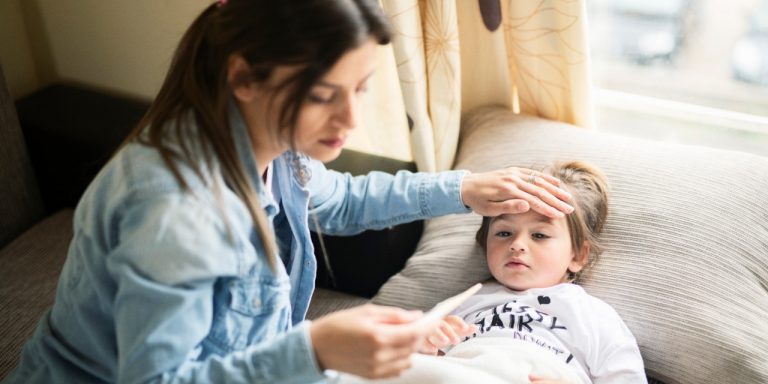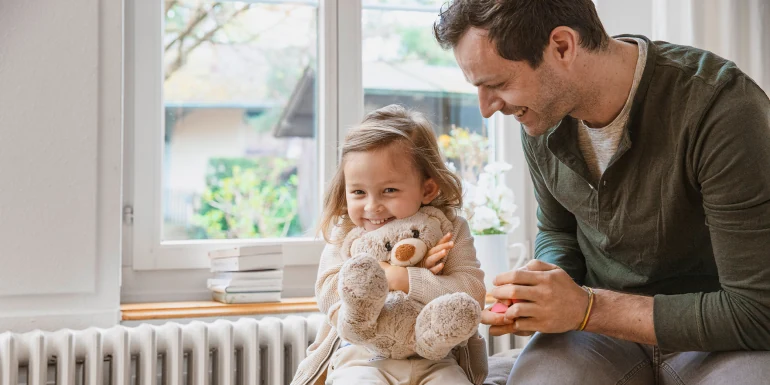
Roseola: progression, symptoms and treatment
Does roseola cause a cough and runny nose? What does the rash in roseola look like, and what are the other possible symptoms? Find out everything you need to know about the progression of roseola and how to treat it.
What is roseola?
Roseola, also known as sixth disease or three-day fever, is a common childhood illness. It mainly affects babies and toddlers and typically presents as a sudden fever that lasts for around three days – hence its nickname. This is followed by a rash that spreads quickly, although it doesn’t usually itch.
Roseola is caused by herpes viruses 6 and 7, which are transmitted primarily when a child breathes in droplets spread by someone coughing, sneezing or talking. This makes roseola highly contagious, although it is usually harmless.
Most children will come into contact with the roseola virus before they turn three. People who have been infected are generally immune for life, which is why it’s rarely seen in older children and adults.
Roseola: symptoms and progression
- High fever: roseola begins with the sudden onset of a fever, which will follow the typical pattern in terms of its progression. The child’s temperature will rise rapidly, up to 41 degrees Celsius. How long does the fever last? Those affected usually have a fever for three days – hence the illness’s nickname of “three-day fever” – although it can last up to five days. Febrile convulsions may also occur in some cases. After a few days, the child’s body temperature will suddenly drop again.
- Rash: after the fever phase, children with roseola will usually present with a rash. The typical roseola rash consists of small, pinkish-red spots. These do not normally itch and mainly appear on the torso. Children with roseola may also develop a rash behind their ears in rare cases.
Less common symptoms of roseola:
- Coughing and a runny nose: roseola can also cause children to develop a cough. They may have a runny nose when suffering from roseola, too.
- Vomiting: roseola can also lead to gastrointestinal complaints such as abdominal pain, vomiting and diarrhoea.
- Swollen neck glands: swollen lymph nodes in the neck are another potential symptom of roseola.
- Swollen eyelids: in rare cases, swollen eyelids are also possible.
The incubation period for roseola, meaning the time between infection and the onset of the initial symptoms, is 5 to 15 days.
Roseola: when should you consult a doctor?
Although roseola is usually harmless, medical advice may be appropriate under certain circumstances. You should consult a doctor in the following cases:
- If you have a baby under 3 months of age with a fever of more than 38 degrees (seek medical advice immediately)
- If your child is between 3 and 6 months old (seek medical advice on the same day)
- If your child feels very sick, or if they are not their normal self, e.g. if they are apathetic or lethargic
- If your child is having febrile convulsions
- If your child won’t drink anything, is short of breath or is suffering from headaches
- If your child has had a fever for more than two days and medicines such as paracetamol aren’t bringing their temperature down
- If you are unsure and/or your child has any other symptoms
Roseola in babies
Roseola is rare in babies in the first few months of life. This is because newborns benefit from what is known as passive immunity, antibodies they get via their mother’s placenta. In babies, fever and a rash can also be signs of their first milk teeth coming through. Unlike roseola, however, the rash occurs on the face during teething.
When it comes to childhood illnesses, it’s not just roseola that causes fever and a rash. Therefore, it’s not always easy to differentiate between illnesses. Other childhood illnesses with skin rashes include:
Roseola: what can you do?
In the case of roseola, treatment is aimed at alleviating the symptoms. Possible measures include:
- Fever-reducing medication: in some cases, roseola can cause febrile convulsions. Treatment may therefore include medication to bring the child’s temperature down if necessary. You can use suppositories or oral suspensions made especially for children that contain ibuprofen or paracetamol as their active ingredients. Remember to discuss the dosage beforehand with a paediatrician.
- Calf compress: calf compresses are an alternative to medication. Add 1–2 tablespoons of vinegar to lukewarm water and soak two cloths in the solution. Then wrap the cloths around your child’s lower legs and place a dry cloth over each one. Allow the compress to work for about 15 minutes.
- Drinking enough fluids: roseola often leads to dehydration, so make sure you give your child plenty of water or unsweetened tea to drink.
There’s no need to treat the rash caused by roseola. It doesn’t itch or cause any other complaints, and what’s more, the rash will clear up by itself after the roseola has run its course.
Roseola: how long will my child be contagious for?
There’s no risk of infection once the fever has subsided. However, since the illness is highly contagious, your child should stay at home until they have been symptom-free for 24 hours and feel well again.
Can you get roseola more than once?
Most people are infected with the roseola pathogens at a young age. How often can you get roseola? It’s rare for someone to catch roseola more than once. As a rule, anyone who’s had it will be immune for life.
Anyone who didn’t fall ill with roseola as a child – and therefore is not immune to it – can catch it at any time. In adults, however, roseola is mild, with flu-like symptoms such as a runny nose and sore throat. Talk to your gynaecologist if you have a high temperature during pregnancy or experience other unusual symptoms.
Roseola mainly affects young children and is usually mild. There’s no vaccination against it. Watch out for symptoms and always consult a medical professional if you notice anything unusual in your baby or if you are at all unsure.

Sabrina Stollberg is a specialist in general surgery recognised by the Swiss Medical Association (FMH) and a research associate in Helsana’s Public Health Sciences team. She provided the editorial team with advice and input for this article.


Newsletter
Find out more about current health issues every month and get all the information you need about our attractive offers from all Helsana Group companies * delivered by e-mail to read whenever it suits you. Our newsletter is free of charge and you can sign up here:
We did not receive your information. Please try again later.
* The Helsana Group comprises Helsana Insurance Company Ltd, Helsana Supplementary Insurances Ltd and Helsana Accidents Ltd.